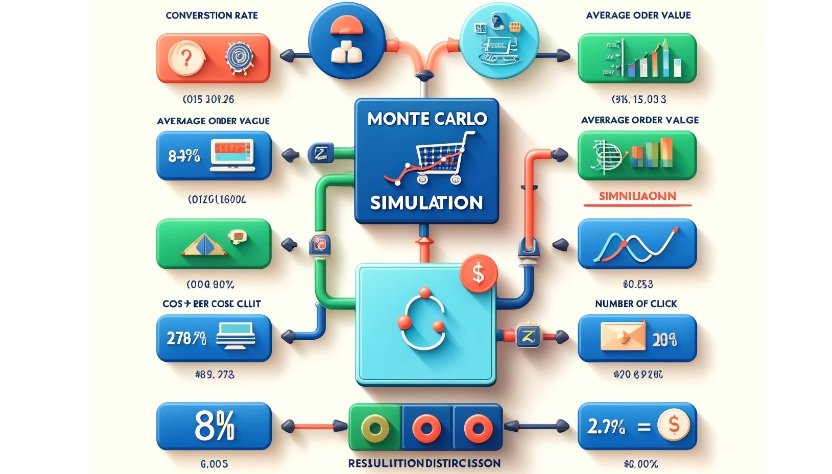Monte Carlo Simulation in Marketing: An Example
In the world of marketing, making data-driven decisions is crucial for optimizing strategies and achieving business objectives. One powerful tool that can help marketers predict outcomes and mitigate risks is the Monte Carlo simulation. This technique, rooted in probability theory, allows marketers to model complex scenarios and understand the range of possible outcomes. In this blog post, I will explore the concept of Monte Carlo simulation, how it applies to marketing, and provide a practical example to illustrate its effectiveness.
What is Monte Carlo Simulation?
Monte Carlo simulation is a statistical method that uses random sampling to model and analyze the behavior of complex systems. I recently wrote an overview blog post about the Monte Carlo Simulation that I recommend you check out if you want to learn more about it. I specifically look at how Monte Carlo can be used in business. There is also a great video you can watch that shows exactly how the simulation works.
Since you are here, here is a real quick overview. Named after the famous Monte Carlo Casino in Monaco, where chance and probability play central roles, this technique enables the prediction of different outcomes based on varying input parameters. By running a large number of simulations, it provides a probability distribution of potential results, helping marketers make informed decisions under uncertainty.
In this post, I want to look at how it can be used within marketing.
Why Use Monte Carlo Simulation in Marketing?
Marketing involves numerous variables and uncertainties, such as customer behavior, market trends, and competition. Traditional deterministic models often fail to capture the full range of possible outcomes, leading to suboptimal strategies. Monte Carlo simulation, on the other hand, allows marketers to:
Assess Risk and Uncertainty: By simulating various scenarios, marketers can identify potential risks and uncertainties in their strategies, enabling better risk management.
Optimize Budget Allocation: Monte Carlo simulation helps in understanding the impact of different budget allocations on marketing outcomes, allowing for more effective resource allocation.
Improve Forecast Accuracy: By accounting for variability in key parameters, this technique provides more accurate forecasts, aiding in strategic planning and decision-making.
A Practical Example: Monte Carlo Simulation for Marketing Campaign ROI
Here is a practical example to illustrate how Monte Carlo simulation can be applied in marketing. Suppose a company is planning a digital marketing campaign and wants to estimate the return on investment (ROI). The key variables involved include:
Conversion Rate (CR): The percentage of visitors who make a purchase.
Average Order Value (AOV): The average amount spent per purchase.
Cost Per Click (CPC): The cost incurred for each click on an ad.
Number of Clicks (NC): The total number of clicks the campaign receives.
Each of these variables is uncertain and can vary based on multiple factors. By using historical data, the company can estimate probability distributions for these variables. For instance:
Conversion Rate (CR): Normal distribution with a mean of 2% and a standard deviation of 0.5%.
Average Order Value (AOV): Uniform distribution between $50 and $100.
Cost Per Click (CPC): Normal distribution with a mean of $1.50 and a standard deviation of $0.30.
Number of Clicks (NC): Normal distribution with a mean of 10,000 and a standard deviation of 2,000.
Step-by-Step Process
Define the Model: Establish the relationships between the variables. For this example, the ROI can be calculated using the formula:
ROI = ((CR×NC×AOV)−(NC×CPC)) / (NC×CPC)
Generate Random Samples: Using the defined probability distributions, generate random samples for each variable. This process is repeated thousands of times to create a large number of possible scenarios.
Run the Simulation: Calculate the ROI for each scenario using the generated samples. This results in a distribution of possible ROI values.
Analyze the Results: The output of the simulation is a probability distribution of the ROI. From this distribution, marketers can determine the likelihood of different ROI outcomes and identify the most probable range.
I Know What You Are Thinking… How Do I Do All of That?
You might be wondering how you actually run the Monte Carlo simulation. The good news is, it is very easy to do in Microsoft Excel. I have embedded a video you can watch to see how easy it is.
Interpreting the Results
The results of the Monte Carlo simulation provide valuable insights into the potential performance of the marketing campaign. For instance, the company can determine:
The probability that the ROI will be positive.
The range of likely ROI values (e.g., 90% of the time, the ROI will be between 10% and 20%).
The worst-case and best-case scenarios, helping in risk assessment and contingency planning.
Conclusion
Monte Carlo simulation is a powerful tool for marketers seeking to make data-driven decisions in the face of uncertainty. By modeling various scenarios and understanding the range of possible outcomes, marketers can optimize their strategies, allocate resources more effectively, and improve forecast accuracy. As demonstrated in our example, this technique can significantly enhance the ability to predict and improve the ROI of marketing campaigns. Embracing Monte Carlo simulation can provide a competitive edge in the dynamic world of marketing, leading to more informed and successful strategies.
